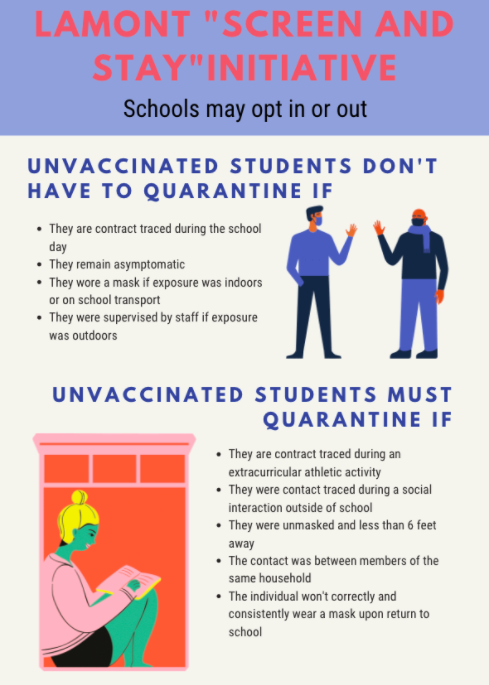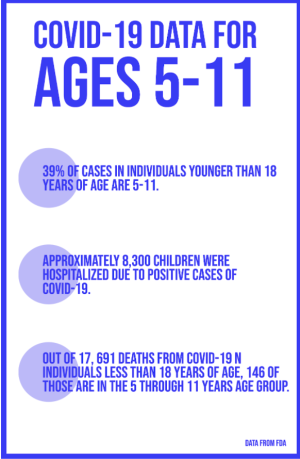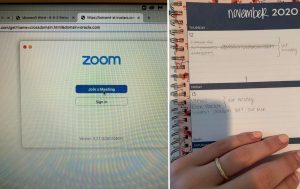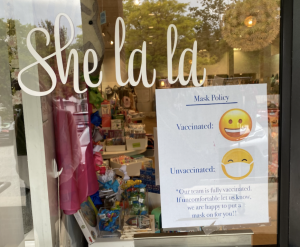Lamont announces optional statewide contact-tracing initiative for schools
Graphic by Natalie Bandura ’22
Governor Lamont’s “Screen and Stay” initiative provides an opportunity for unvaccinated students and staff to remain in school when contact-traced. Certain criteria must be met for contact-traced unvaccinated persons to continue attending school under these rules.
Governor Lamont announced the rollout of the “Screen and Stay” initiative for Connecticut schools on Nov. 4. For schools that choose to participate, unvaccinated or partially vaccinated students and staff who are contact-traced to someone who tested positive for COVID-19 may remain in the building as long as they continue to wear masks and do not develop symptoms. Fully vaccinated students are currently not required to quarantine when they are contact-traced.
The initiative only applies to students and staff who are contact-traced under certain parameters. The contact must have occurred during the school day, and the contact-traced individual must remain asymptomatic. If the exposure occurred indoors or on school transportation, both the contact and the COVID case must have been masked during the exposure, with only brief unmasked periods in which at least six feet of distance was maintained. If the exposure occurred outdoors, they must have been supervised by a staff member.
“Throughout this pandemic, we’ve consistently done our best to maintain a safe learning environment for all students and staff, while also understanding that students achieve the greatest outcomes when they have access to in-person learning,” Governor Lamont said in a Nov. 4 press release. “The Screen and Stay initiative will help ensure that more students can remain in school and we can provide a safe, in-person learning environment.”
Matthew Lott ’22 supports the initiative and hopes that it becomes adopted by the Staples administration, as he believes that a substantial enough portion of the Staples population is vaccinated for the Staples administration to take steps towards returning to pre-pandemic normalcy. Thus far, the school has only had nine positive COVID cases this year. In comparison, there were 232 cases of students testing positive for COVID last year as of March 19, according to WestportNews.
“This seems like an important first step in a long line of steps which will lead us towards a COVID-free world,” Lott said. “Hopefully with herd immunity, the unvaccinated students will be protected and they won’t get the virus in the first place.”
Quinn Mulvey ’23 believes the decision of whether or not Staples should adopt the “Screen and Stay” guidelines should rest on the opinions of experts about how necessary it is for unvaccinated students and staff to quarantine.
“I think it’s really hard now, because what we’re going through is so unprecedented, to know if the policies that are being enforced are beneficial or are harmful,” Mulvey said. “But if that’s where the science is, then I support it.”
According to CDC guidelines for K-12 schools as of Oct. 19, students or staff who are not fully vaccinated and are determined to be a close contact to someone with COVID must quarantine for the full 14 days, regardless of the specific circumstances of the contact or whether or not they developed symptoms.
Nicky Fabian ’24 proposes an alternate solution to amending the contact-tracing protocols, in which unvaccinated students and staff who are contact-traced would not have to quarantine only in the event that they obtain a negative test result.
“You should have to quarantine if you don’t get a test because we don’t know if you have COVID, so we have to stay safe and take the most extreme precautions necessary,” Fabian said. “If you get a test and you’re negative, then I think you should be able to go back in to school, but if you’re positive when you get a test, you need to stay home and quarantine.”

Editor-in-Chief Natalie Bandura '22 shares an interest for political science and the STEM fields.
From a Fall 2020 internship with Senator Will Haskell...
























































